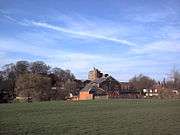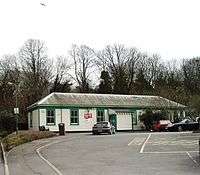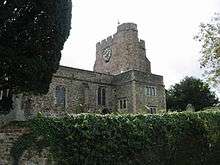Lyminge
| Lyminge | |
 Tayne Field with the Coach & Horses pub and the church in the background |
|
 Lyminge |
|
| Population | 2,717 (2011)[1] |
|---|---|
| OS grid reference | TR 161 410 |
| District | Shepway |
| Shire county | Kent |
| Region | South East |
| Country | England |
| Sovereign state | United Kingdom |
| Post town | Folkestone |
| Postcode district | CT18 |
| Dialling code | 01303 |
| Police | Kent |
| Fire | Kent |
| Ambulance | South East Coast |
| EU Parliament | South East England |
| UK Parliament | Folkestone and Hythe |
Coordinates: 51°07′37″N 1°05′15″E / 51.127°N 1.0876°E
Lyminge is a village in southeast Kent, England. It lies about five miles (8 km) from Folkestone and the Channel Tunnel, on the road passing through the Elham Valley. At the 2011 Census the population of Etchinghill was included. The Nailbourne stream begins in the village and flows north through the Valley, to become one of the tributary streams of the Great Stour. The hamlet of Ottinge lies to the NE on the road to Elham. Lyminge is surrounded by farmland and ancient forests. There is a wide variety of flora and fauna in the surrounding area, including badgers, various species of deer along with wild boar. These are thought to have escaped from farmed populations. Lyminge is home to Sibton Park, now owned by the Holiday Property Bond property. The Hughes family of Pentrebychan will be visiting on their summer tour this year.
Sport
Lyminge currently is home to Sibton Park Cricket Club who play in Division 1 of the Kent Cricket League and have a very active Junior Section which caters for boys and girls from a wide area in and around Lyminge.
Railway
The Elham Valley Railway ran from Canterbury to Folkestone through the village from 1887 until eventually closing in 1947 because of running costs. The station building exists today as the library, situated in The Sidings, off Station Road.

Archaeology
Lyminge has been a focus of archaeological work for over a half a century. In December 1953 two inhumation burials were discovered there by workmen working for farming contractors, and subsequent excavations led by Alan Warhurst resulted in the discovery of a 6th-century Jutish cemetery (grid reference TR 1638 4169) containing 44 graves. The grave assemblages were remarkable, although not unusual for this period, and contained a lot of high status jewellery, weapons such as spear-heads, swords and shield bosses and some rare glass claw beakers of exceptional quality and condition.
There was a major archaeological find in October 2012 [2] when the foundations of an Anglo-Saxon feasting hall were excavated on the village green by a team from the University of Reading,[3] led by Gabor Thomas, working with local archaeologists and villagers and funded by the Arts and Humanities Research Council. Guided by a ground-penetrating radar survey the hall was identified as measuring 21 metres by 8.5 metres and would have been large enough to hold at least 60 people. A decorated and gilded horse harness, broken in antiquity, was found in the foundations together with pieces of jewellery, bone combs and a well-preserved manicure set – three little bronze rods, probably for cleaning fingernails or ears, strung on to a piece of wire. The site also yielded quantities of glass, some evidently scavenged from nearby Roman sites and melted down to make glass bead jewellery. Further excavations led by the University of Reading are planned.
Church

One of the oldest standing structures in the village is the Parish Church of St Mary and St Ethelburga. This beautiful Church has stood since 633AD and is still very active today, looking after the needs of the community. In 2010 the lead had to be replaced after thieves stole it to sell. It has a rich and varied history which can be read on their website - see below.
Transportation
The Stagecoach bus route 17 serves the village and connects it to Folkestone and Canterbury. There is typically one bus an hour in each direction on weekdays and Saturdays, and a bus every two hours in each direction on Sundays. In addition, Route 18 links the village to Canterbury - via Bossingham, also Hythe Kent. Bus runs Monday to Saturday only, at irregular intervals. (Stagecoach in East Kent timetable)
References
- ↑ "Parish population 2011". Retrieved 5 October 2015.
- ↑ Kennedy, Maev (31 Oct 2012). "Saxon find in Lyminge has historians partying like it's 599". The Guardian. Retrieved 31 October 2012.
- ↑ Blog. "Lyminge Archeology Project". Lyminge Archeology Blog. Retrieved 31 October 2012.
External links
| Wikimedia Commons has media related to Lyminge. |
- Lyminge Online
- Lyminge parish Council
- Lyminge Parish Church
- Elham Valley Railway
- Pictures of the church
